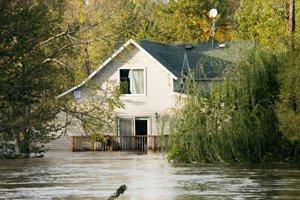Flood Damage: What To Do Next
See if We Have Top-Rated
Home Maintenance in Your Area

After a flood, many people revisit their homes to determine the water damage first hand rather than have an insurance agent tell them the story. Certainly, this is a difficult time for families who have seemingly lost everything, but there are particular things you can do to ensure safety, damage assessment and the best and quickest way to water damage restoration.
Safety First
Do not return to your home until it has been declared safe by emergency management officials. There are many dangers that may lurk in flooded areas: unstable structures, dangerous floating debris, unsure footing, diseased water, etc. Make sure there is no live power. If you can't turn it off through the breaker box, wait for the power company to check it out.
Once your home has been cleared for reentry, continue to follow safety guidelines. Be aware of loose or downed power lines and damaged utilities. Just be one your toes, and devise escape routes before you go down a flooded a street or enter a flooded building.
Assessment
To the best of your ability and resources, prepare a visual record of the water damage. Take pictures or film on all sides of the home and yard. Don't forget the roof and any utilities connected to the home. If filming, try to narrate the shots. For pictures, write captions on the back.
Before you enter the home, be certain that the structure is stable. Water can do funny things to wood and plaster and this might not be readily visible. If there is any doubt, don't go in. What you can do from the outside is board up any broken or knocked out windows with plywood or cover with a heavy plastic. During these times there's likely to be a shortage of materials, so you might have to use some imagination for what to use.
If you are knowledgeable about how to brace walls and support structures, it's a good idea to brace anything that might buckle. Next, determine how much, if any, water is still in the basement. Remember how high it is on the wall or use some relative measure.
If you have a pump and are cleared to pump water from your home, do so very slowly. If the basement is full, only pump out about a third of the water each day. Water of this volume puts an extreme amount of weight on load-bearing structures and soil. If the water is removed too quickly, structures that withstood the pressure of the water may buckle under having it removed too quickly. It sounds crazy, but just pump slowly.
Once you've gathered this initial assessment, no matter how incomplete it might be, show it to contractor who handles water damage restoration.
Initial Repair and Cleaning
Depending on the damage, there might not be much to do. If the damage is not total, you can do a few things to make your life and home feel normal again. If you need a generator for some power or a lighting source, make you to read up on generators before buying or using one after a flood.
Once plastered walls have dried, brush off the loose dirt. Wash with mild soap and clean water. Start at the bottom and work up, just the opposite of washing a car. The lower floors and lower parts of floors will have the most damage. Clean ceilings last. It's also important to clean out heating and plumbing systems.
Clean metal at once, then wipe with a kerosene-soaked cloth. A light coat of oil will prevent iron from rusting.
If the building has shifted or the floors have settled badly, it may be necessary to install temporary bracing until extensive work can be done.
Most flood damaged appliances won't be in good condition, but if you think something can be salvaged, take whatever items might still be good to an appliance professional. Beyond this, it would be a waste of time cleaning a floor that needs to be ripped out or shoring walls that will be torn down.
A service professional will need to be called in to accurately assess the damage or possibly rebuild.
Who to Hire
After a natural disaster like a flood or hurricane, the demand for qualified contractors often exceeds the supply. Many contractors hike-up prices to take advantage of the demand while others who would have never gotten a job see their offices swamped with repair requests. While you may feel the desperation to remediate your home as quickly as is humanly possible, don't make a hasty decision just to have results.
Make sure you only deal with licensed contractors. If you have any doubts, check them through their clients list or the Home Builders Association. It's also important to get a first-hand account of their work and expertise. Don't be shy about asking for references. This is your home.
Always pay using a check or credit card so that your payment will be traceable. A standard payment policy for a renovation project is to give the contractor a deposit of one-third of the total costs of repairs and pay the final amount only after the job has been finished to your liking. If you want a better payment plan, it doesn't hurt to ask.
More Tips & Advice For Your Home
- Related Articles

